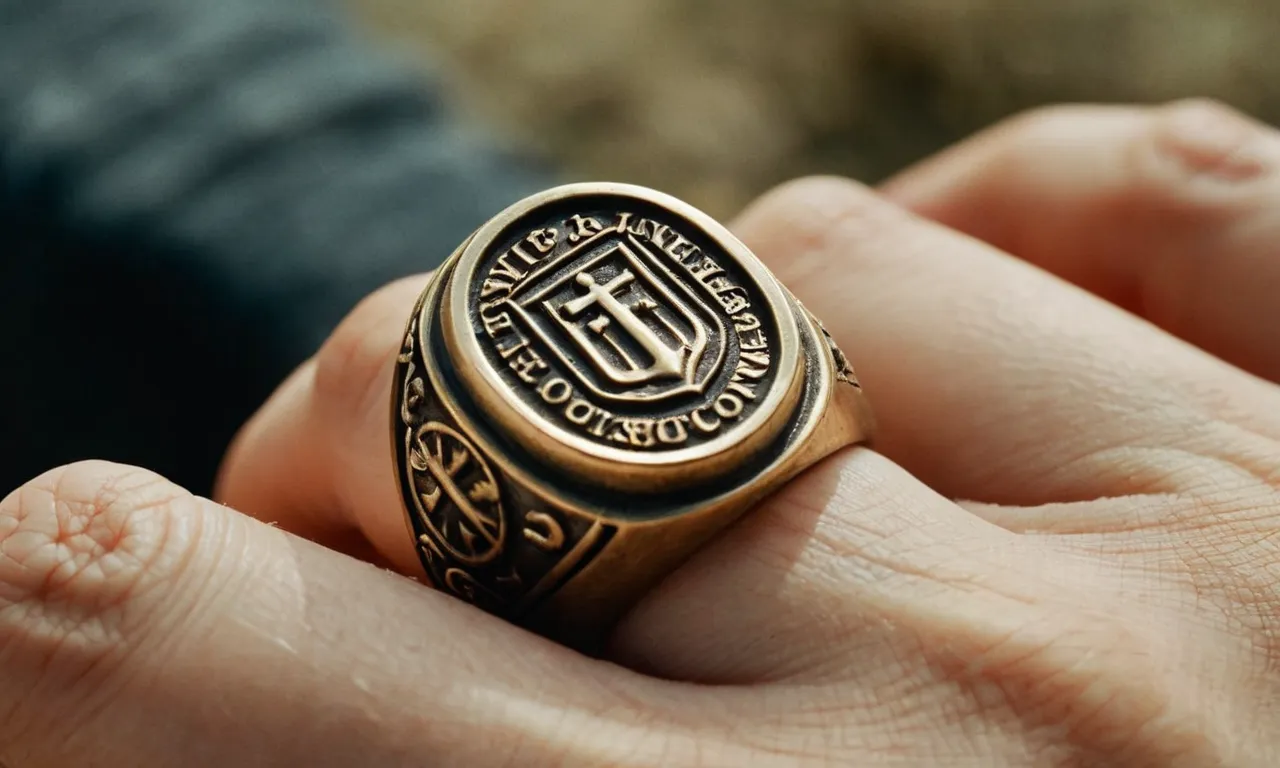What Is A Signet Ring In The Bible?
If you ever wondered what a signet ring is when reading the Bible and what significance it held, you’re not alone. Signet rings played an important symbolic and functional role in ancient Biblical times, denoting authority and sealing important documents.
If you’re short on time, here’s a quick answer to your question: A signet ring in the Bible was an engraved gemstone ring used to seal letters, decrees and other important documents with the owner’s unique mark or emblem. It signified power, honor and authority.
In this comprehensive guide, we’ll explore the history of signet rings, their use and meaning in Biblical accounts, different materials used, the significance of the engraved seal design, and more.
What is a Signet Ring
A signet ring is a ring bearing a personal emblem or seal used to stamp one’s signature for authentication. Signet rings have been used throughout history as symbols of authority, honor, and identity.
Definition and Purpose
The word “signet” comes from the Old French “signete” meaning little seal. A signet ring has an engraved design on the face of the ring that acts as a personalized seal for stamping wax or soft metals.
The purpose of a signet ring is to indicate the identity of its owner and to verify the authenticity of documents by impressing the design into wax or metal.
Kings, nobles, and high-ranking officials traditionally used signet rings to seal formal correspondence and decrees. The ring conferred authority and legitimacy. Even today, signet rings are sometimes used to seal ceremonial documents or add a symbolic signature.
Beyond official purposes, they also indicated social status and family heritage.
Materials Used
Signet rings can be made from various materials including:
- Precious metals – Gold, silver, and platinum are common. Gold signet rings were popular among nobility and the wealthy.
- Gemstones – Many feature inset gems like carnelian, onyx or lapis lazuli. Stones were believed to have protective powers.
- Less costly metals – Brass, copper, iron or steel signet rings were accessible to merchants and commoners.
The choice of material depended on the owner’s social rank and wealth. Royal signets were often made of gold with intricate detailing. The material also needed to be hard enough to imprint designs without excessive wear.
Engraved Design Significance
The engraved design on a signet ring carries great significance:
- Heraldic symbol – Signets often feature coats of arms, family crests or national emblems.
- Monogram or initials – The initials or monogram of the wearer is a popular design.
- Personal icon – Images of animals, flowers, astrological signs and religious symbols conveyed personal meaning.
- Motto or inscription – Phrases or short inspiring quotes are sometimes engraved.
The purpose of the personalized design was to unequivocally identify the owner. Over time, trends shifted towards simpler engraved initials or monograms even among royal signets. But symbolism and heritage remain hallmarks of signet ring design today.
Signet Rings in the Bible
Old Testament References and Symbolism
Signet rings are mentioned several times in the Old Testament as symbols of power and authority. In Genesis, Pharaoh gave Joseph his signet ring, placing Joseph in charge over all of Egypt (Gen 41:42).
King Ahasuerus used his signet ring to authorize decrees that allowed the Jewish people to defend themselves from their enemies (Esther 8:2, 8). Signet rings were also used to seal letters and documents.
In the ancient Near East, signet rings were usually made of stone or metal and engraved with the owner’s name, title or insignia. They would be pressed into wet clay or wax to leave an impression as an official seal.
Kings, nobles and high officials often wore signet rings on their right index finger as a symbol of their prestige and authority.
New Testament References
In the New Testament, Jesus told a parable about a prodigal son whose father ordered his servants to bring out the “best robe” and “a ring” for his son when he returned (Luke 15:22). This signified the restoration of the son’s privileges and authority in the household.
The author of James wrote, “Let not many of you become teachers, my brethren, knowing that as such we will incur a stricter judgment” (James 3:1). The word “teachers” literally means “masters” in Greek, referring to those with authority.
Some scholars believe James was alluding to teachers wearing a signet ring, representing their authority and responsibility.
Archaeological Discoveries
Archaeologists have discovered signet rings in ancient Near East sites that date back to before 1000 BC. Notable examples include the 9th century BC King Hezekiah bulla and 6th century BC Baruch bulla found in Jerusalem.
These clay seal impressions contain imagery and Hebrew inscriptions identifying them as belonging to King Hezekiah and Baruch, a scribe mentioned in the book of Jeremiah. These archaeological discoveries attest to the biblical descriptions of signet rings as concrete artifacts of the ancient world.
Some of the most exquisite signet rings were found in the Royal Cemetery of Ur from 2600-2500 BC. These rings feature intricate designs and lapis lazuli from Afghanistan, illustrating the importance and prosperity of ancient Sumer.
Famous Biblical Signet Ring Owners
King Ahasuerus (Xerxes I)
King Ahasuerus, also known as Xerxes I, is one of the most famous signet ring owners in the Bible. As depicted in the Book of Esther, Ahasuerus used his signet ring to authorize royal decrees. At one point, he gave the ring to his wife Esther, allowing her to issue decrees in the king’s name to save the Jews from destruction.
Mordecai
Mordecai was Esther’s cousin in the Book of Esther. After saving the king’s life by uncovering an assassination plot, Mordecai was given the king’s signet ring by Esther. This ring gave Mordecai the authority to issue decrees on behalf of the king, which he used to countermand the order to kill the Jews.
King Jehoiachin
The signet ring of King Jehoiachin is mentioned in the Book of Jeremiah. When Babylon conquered Jerusalem in 597 BC, King Jehoiachin was taken into exile. Yet archaeological evidence shows that while in exile Jehoiachin retained authority to make economic transactions using his royal signet ring.
Judah’s Royal Signet Ring
The governor of Judah, Zerubbabel, is described as wearing a royal signet ring in the Book of Haggai. This indicates he had authority from the Persian Empire to govern Judah. Signet rings were thus an important symbol of delegated authority to Jewish leaders during the time of exile and return to the land of Israel.
The Significance of Signet Rings Today
Modern Signet Ring Use
Signet rings continue to be popular fashion accessories and symbols of personal identity in modern times. While no longer used to seal wax on documents, they remain a classic jewelry style that conveys personal flair.
Many families pass down signet rings through generations as heirlooms. The engraved family crest or insignia connects the wearer to their heritage. Companies also frequently gift custom signet rings to top executives or award them to outstanding employees as symbols of status.
In addition, signet rings often indicate membership in a school, club, or other organization. For instance, many elite universities present signet rings to graduates. Engraved with the university seal, these rings demonstrate alumni status.
Signet rings also see use as fashionable accessories among men and women today. Luxury designers like Tiffany & Co. and Gucci offer sophisticated signet rings featuring precious metals and gems. Many people enjoy the vintage appeal of the ring style. The custom engraving adds a personalized touch.
Signet Rings in Christianity
In Christianity, signet rings hold special meaning for clerics and some congregations. Bishops traditionally receive signet rings upon ordination. The ring bears the bishop’s coat of arms or other insignia. It represents the bishop’s authority and spiritual marriage to the church.
In addition, some Christian denominations use signet rings ceremonially. For example, Latter-day Saints exchange temple garment rings during marriage. Engraved with clasped hands, these special signet rings remind couples of their vows.
Some churches also present youth with purity rings to symbolize chastity. These rings may feature religious imagery and Bible verses. Wearing a signet ring can affirm Christian values for modern believers.
Conclusion
As we’ve explored, signet rings held great symbolic, functional and authoritative significance for their owners in Biblical history. The engraved seal designated power and honor. While less commonly used today for legal documents, signet rings endure as symbols of tradition and heritage.








